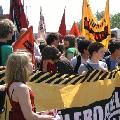
On 9 June, 85,000 school, university, and apprenticeship students went on strike against cuts in education, tuition fees and increasing pressure to "perform" in education.
This was the third strike in the last year. Two days earlier, an 80 billion euro austerity package was announced by the federal government.
After the strikes of 2009, in which 270,000 people participated, the federal government promised a review of the “Bologna reforms”, more money for students and better funding of education. But in response to the debt crisis, this promise has been put into question. In the states of Hessen and Schleswig-Holstein, cuts in education and higher education were implemented in May. With the announcement of the austerity package on 7 June, the federal government, despite avoiding cuts in education, made clear that they want young people, the unemployed and workers, to pay for the crisis. This was reason enough to go out on strike.
Education strike

The strike on 9 June was planned long beforehand. Due to the political weaknesses of the forces involved in the strike, the layer of activists was quite small and there was no strategy of how to organize a successful struggle. This resulted in worse preparation of this strike, than has been the case in the past with previous protests.
Nevertheless, 85,000 people went on strike. Especially remarkable was the city of Kassel. With the involvement of members of SAV (CWI in Germany), the education strike could mobilise apprenticeship students to the well organised 3,000 strong demonstration in a city of under 200,000 inhabitants. Over 300 young workers came from the local VW car factory. In addition smaller delegations from the Daimler car factory, other metal factories and from the city hospital were also involved.
Nationwide, apprenticeship students and students from Telekom could have participated in the demonstrations. But without further protest from the public and service sector trade union, ver.di, the employer forbid gatherings of apprenticeship students and prevented their participation.

Make Capitalism History
The biggest demonstration was in Berlin, with around 7,000 people attending. The mood was militant and anti-capitalist. SAV member, Lucy Redler, received huge applause for her speech saying: “We want money for education instead of banks. In order to achieve this, we not only have to demonstrate for better education, but for the breaking of the powers of Banks and Companies over our lives.”
Members of SAV took the opportunity to build up the youth organisation of DIE LINKE, called Linksjugend [’solid] as a socialist youth organisation. We produced leaflets for the strike, gave speeches and helped with a good Linksjugend [’solid] intervention. Nevertheless, SAV members also sold the second issue of the SAV paper’s youth supplement ,.megafon, on the demonstrations.

The struggle goes on
The strike showed that school students, students and young workers will continue to struggle. Two large demonstrations in Berlin and Stuttgart against the effects of the crisis have been planned for some time to take place on 12 June. Young people will participate with their own contingents in these demonstrations. Common struggle and strikes of workers, youth and the unemployed are needed against cuts and attacks on jobs and living conditions. Activists from the education strike movement, trade union youth and Linksjugend [’solid] will discuss proposals for next steps at a youth conference on 19 June in Kassel.
Special financial appeal to all readers of socialistworld.net |
Support building alternative socialist media Socialistworld.net provides a unique analysis and perspective of world events. Socialistworld.net also plays a crucial role in building the struggle for socialism across all continents. Capitalism has failed! Assist us to build the fight-back and prepare for the stormy period of class struggles ahead. Please make a donation to help us reach more readers and to widen our socialist campaigning work across the world. |
Donate via Paypal |
| M | T | W | T | F | S | S |
|---|---|---|---|---|---|---|
| 1 | 2 | 3 | 4 | 5 | 6 | |
| 7 | 8 | 9 | 10 | 11 | 12 | 13 |
| 14 | 15 | 16 | 17 | 18 | 19 | 20 |
| 21 | 22 | 23 | 24 | 25 | 26 | 27 |
| 28 | 29 | 30 | ||||


Be the first to comment